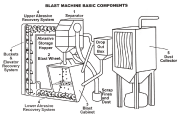E-Archive
From the World of Blasting
in Vol. 23 - July Issue - Year 2022
Key Function of a Blast Machine (part 2 of 3)


The following will give an overview of the key functions of a Blast Machine, and should give you a basic understanding of how to adjust and maintain these parts to ensure the machine operates at the highest possible level.
Wheel Blast Machine Basics
1. The Separator
The separator is a key element in any blast machine. The separator is usually combined with the abrasive storage hopper and is usually above the storage hopper. The cleaned abrasive can fall directly into the hopper. The separator, when set properly, maintains the abrasive operating mix by cleaning and classifying the abrasive recovered by the abrasive reclamation system from the cabinet. The separator removes all contaminates such as dust, dirt, gloves, ear plugs, welding rod, and undersized abrasive to maintain a proper operating mix.
Most separators have a rotary screen to remove oversized contamination and deposit contamination into the trash chute. Separators without rotary screens have a screen deck located near the top of the elevator for this purpose. These screens must be cleaned at least daily to remove all contamination and prevent clogging of the separator. When the separator is set properly, the contaminated abrasive is passed over a stationary lip in a uniform, continuous and uninterrupted abrasive curtain in front of a controlled flow of air.
The removal of the contaminants is accomplished by drawing a continuous controlled flow of air through the uniform abrasive curtain to remove the contaminants and undersized particles.
The air stream carrying the contamination and undersized abrasive passes through the air orifice and into the expansion chamber. The velocity of the air decreases in the expansion chamber and the larger dust particles and small metallic fines fall out of the air stream and are sent down the discard chute into the garbage. The balance of micronic dust is carried out to the dust collector. The efficiency of the separator is dependent upon an uninterrupted and uniform flow of air through the abrasive curtain.
Note: It has been proven that as little as 2% out-of-spec material (dust, dirt, etc.) in the abrasive operating mix can cause an increase of 50% in the wear of the major parts of the machine (wheel blades, wear liners, shed plates, etc.). This same out-of-spec material is the root cause of backside contamination.
2. Blast Wheel Assembly
Wheels are the throwing units that propel the abrasive so the abrasive may accomplish its work. The efficiency of a blast machine with the proper abrasive operating mix is reliant on the efficiency of the wheels, measured in pounds of abrasive thrown per minute.
There are five major components that make up a Blast Wheel Assembly:
A. Feed Funnel: Directs abrasive into the center of the impeller
B. Impeller: Bolted to the wheel assembly. Times and pumps the abrasive onto the blades.
C. Control Cage (Impeller Case): Bolted to the wheel housing. The control cage is stationary and controls the shape/location of blast pattern.
D. Blades (Vanes): Secured into wheel assembly by locks or stops.
E. Bare Wheel Assembly (Runner Head): Single or double faced. Holds blades and impeller.
3. The Blast Cabinet
Blast cabinets come in many shapes, configurations, and sizes. The cabinet’s main function is to surround the work handling system, support the wheels in their chosen location, and contain as best as possible the overspray and ricochet abrasive from the wheels in a safe manner.
4. The Abrasive Recovery System
The abrasive recovery system is a necessary component of the blast machine. The recovery system’s function is to maintain an adequate supply of the abrasive recovered from the blasting process to the separator for cleaning. This keeps the abrasive hopper full so that wheel assemblies can operate efficiently. Typically, the recovery system has some type of coarse scalping ability in the blast cabinet to help remove tramp material from the abrasive that could damage or jam the recovery screws, shaker pans, or elevator system.
5. The Dust Collector System
The dust collection system is an integral and important component of the abrasive blast cleaning system. However, the dust collector is usually the most neglected and least understood part of the blast cleaning system. To operate effectively at reasonable costs, a blast cleaning system must be ventilated properly.
Contact:
chris.prouty@winoagroup.com
To be continued in the next
issue.....
Written by chris prouty, Contributing Editor for MFN and Technical Advisor at Winoa



























